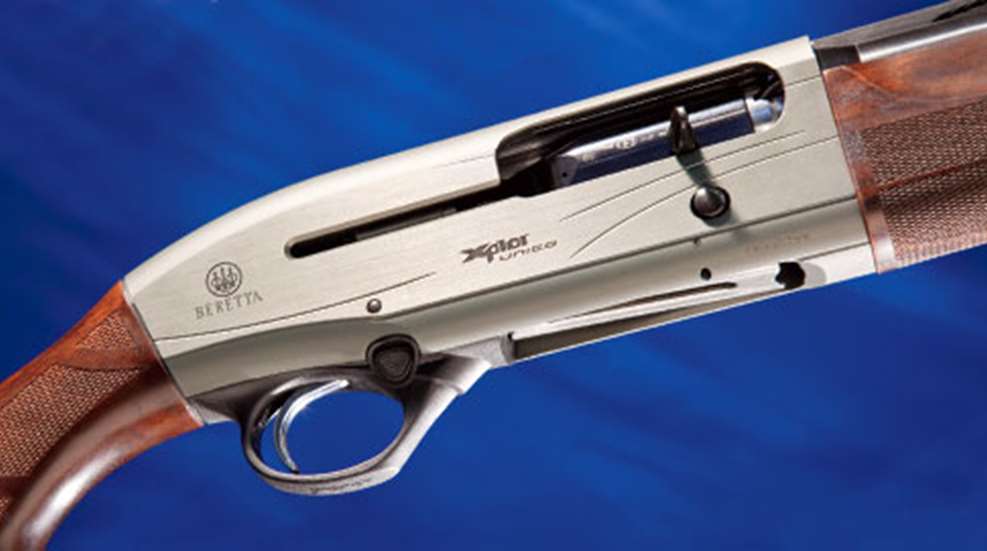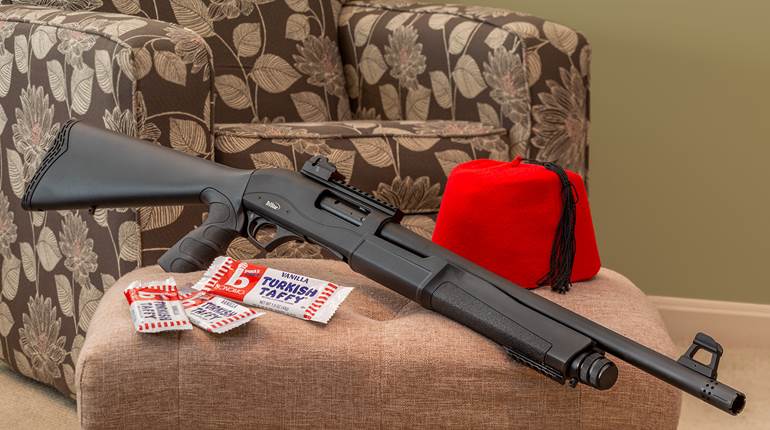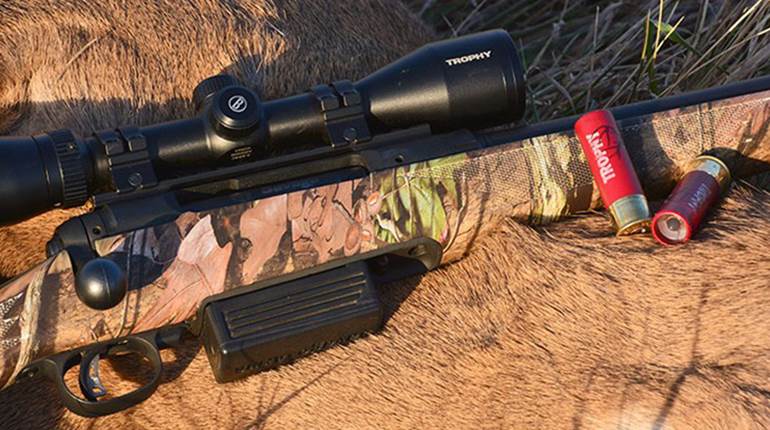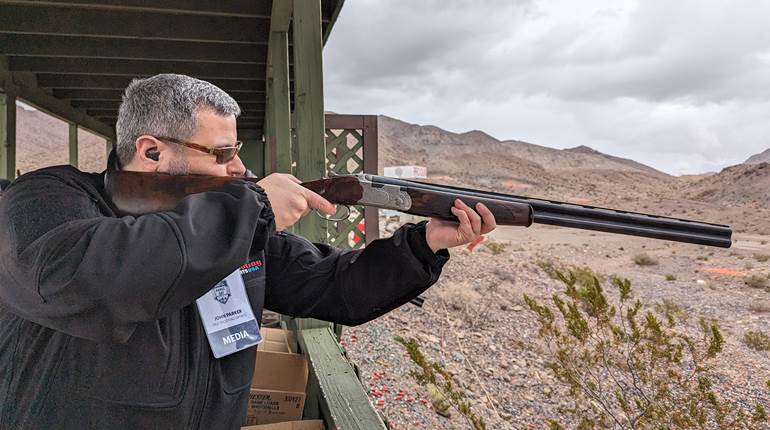
If you do the math, you’ll find that 1 1/2 ounces of HEVI-Shot No. 2s at 1450 fps fired from a 7-pound shotgun generates a head-jarring 55 ft.-lbs. of recoil energy—slightly more recoil than a 10-pound .416 Rem. Mag. rifle. Yet recently when I pulled the trigger on the aforementioned load pointing at a Canada goose skirting my decoys I felt nothing more than a bump against my shoulder. Unjolted by recoil, it was easy for me to swing from the first bird to a second goose climbing out of the spread at 40 yards. Twenty-five pounds of giant Canada geese collapsed into the snow and corn stubble.
That I felt almost no recoil while making that double could be attributed to excitement and focus. It can also be attributed to the many layers of clothes I wore in that December snowstorm, but mostly, it can be attributed to the gun that was in my hands that day. Beretta’s newest semi-automatic shotgun, the A400 Xplor Unico, combines gas operation with a stock-mounted recoil-reducing system to make it one of the softest-shooting field guns I’ve ever tried. The A400 is a gun for nearly all seasons and purposes: easy to carry in the uplands, reliable with very light loads, yet able to absorb the recoil of heavy goose loads, even 3 1/2-inch shells.
The Green Monster
Despite the name “Unico,” the A400 isn’t truly unique. Every manufacturer’s semi-automatics get lighter and more reliable each year. What sets the A400 apart from the competition are its gray-green receiver; its magnum price tag; and the definite possibility that it really does live up to Beretta’s claim that the “Green Monster of Technology” (their nickname for it, not mine) really is the most advanced semi-automatic shotgun on the market.
A while ago I wrote in another magazine that the A400’s predecessor, the A391, was so great there would never be an A392. I was so wrong that I was right. Beretta skipped numbers A392 through A399 and designated this new semi-automatic “A400” with good reason: The Xplor shares many traits of the long-running and successful 300 series, but it borrows even more heavily from the Xtrema/Xtrema 2 line. The result is a gun that differs enough from both the 300s and the Xtremas to merit its own numbered series.
The A400 Xplor is a gas-operated, 12-gauge semi-automatic with a 3 1/2-inch chamber. The receiver has the familiar lines of a Beretta 390/391. In fact, the Xplor’s receiver is the same length as the 390/391’s receivers despite accommodating 3 1/2-inch shells. The new gun’s receiver is taller, however, measuring 1/8 inch more than my 390 and a 1/4-inch taller than a Remington Model 11-87 receiver.
The stock and fore-end have Beretta’s Xtra wood grain enhancement, giving the furniture an appearance of dark, highly figured grain at a distance. The Xtra wood has an oil finish and a checkering pattern with Beretta’s trident logo on the fore-end. The trigger guard and fore-end tip are polymer, as is the magazine cap, which is the same complex seven-piece design of the 391 (it helps dampen vibrations), but 3 ounces lighter and made of non-seizing polymer and Ergal (performance aluminum). The gun is decorated with some of the usual swoops, accent lines and other concept-car-style touches that afflict modern guns, but overall, the A400 is handsomely contemporary without crossing over the line to radical Euro styling.
What’s Inside
Before you take the A400 apart to look inside, you can see a rotary bolt like the Xtrema’s (almost identical to the bolt on a Benelli) that turns to lock into the barrel. Rotary lock-ups are strong and fast; in fact, Beretta claims the A400’s “Blink” action cycles 36 percent faster than any other semi-automatic, and it has promotional pictures of people shooting the gun with four smoking hulls in the air at once to prove it. Removing the fore-end reveals a return spring coiled around the magazine tube, like the Xtrema, not tucked away in the buttstock where it’s difficult to reach, like on many semi-automatics. The spring and bolt are held together in one assembly by a composite buffer, twin operating rods welded to the bolt body at the rear and to a ring that holds the spring in place in front. Although the group can be disassembled for detailed cleaning, the bolt, sleeve, buffer, spring and arms all come out of the gun as one unit, making for convenient disassembly.
Although the return spring and bolt resemble the Xtrema’s, the rest of the gas system is clearly derived from the 300 series, especially the exhaust valve consisting of a short, stout spring on the front of the barrel ring. Part of the goal set for the A400’s engineers was to simplify the internals of the gun; the exhaust valve of the 391 was such a chore to take apart and clean that there are aftermarket wrenches made specifically for the task. While the A400’s exhaust vent looks similar, it has been redesigned so you don’t have to take it apart. The manual reads: “NEVER DISASSEMBLE the exhaust valve assembly.” That alone is almost reason in itself to trade your 391 for a 400.
Inside the barrel ring you find a redesigned piston, which has neither the O-rings of the Xtrema nor the nooks and crannies of the 391 piston that make it so difficult to scrub. You can clean this one in seconds with a few swipes of a brush. The A400 piston omits the little feet of the 391’s piston that sometimes broke. There’s only one gas port into the barrel, and it’s smaller than the 391’s twin ports because of the new gas system’s better efficiency.
Softening The Blow
Although the Beretta gas system reduces felt recoil, I have never thought Berettas shot as softly as Remingtons and Brownings. Once that recoil reduction is aided by the Kick Off 3 system, however, the gun kicks less than any semi-automatic I know of. The A400 features a shock absorber inside the stock that protrudes into the rear of the receiver, cushioning the bolt as it travels backward. Beretta claims the new system reduces recoil further by dampening the secondary recoil of the bolt’s impact. That’s probably true, although I can’t say how much it changes the shooter’s perception of recoil. What is more certain is that the arrangement should prolong the life of the gun, as the battering of bolts against receivers wears on actions.
The buttpad Kick Off system is an option that adds $100 to the price and, according to my shoulder, is worth every penny. Already found on Xtrema2s and Prevail over-unders, Kick Off consists of a buttplate that under recoil compresses two hydraulic shock absorbers in the stock, turning the peak jolt into a mild shove. To further soften the blow, the A400 has Beretta’s newest recoil pad, the soft Micro Core. The Kick Off reducer adds some weight, so my 28-inch-barreled gun weighs right at 7 pounds, somewhat more than the 6.6 pounds advertised. Despite the light weight, the A400 was comfortable to shoot both with magnum waterfowl loads and with stout 3-dram, 1 1/8-ounce target loads on the skeet field.
The forcing cone features a lengthened taper for improved patterns and a bit more recoil reduction. The barrel is slightly overbored, again for patterning and to cut down on kick, albeit slightly. The barrels are made of nickel-chromium-molybdenum alloy, deep drilled, hammer forged and vacuum distended by a process Beretta insists on calling “Steelium” technology. While that sounds like marketing-speak to me, let’s remember that Beretta was founded by maestro da canne (master barrel-maker) Bartolomeo Beretta in 1526. The company’s first known product was arquebus barrels. I am willing to believe that after 484 years in the business, Beretta quite possibly knows more about barrel making than I do.
Field Testing
Last year I attended Beretta’s unveiling of the A400 Xplor Unico at its factory in Italy, and after returning home to the states, I received a sample for evaluation. With the drop and cast shims set down to give the stock the greatest amount of drop, the Xplor fit me, and the 14 1/4-inch length of pull was about right for heavy winter clothes. The gun functioned perfectly; it was light to carry and pointed very well for me despite its tall profile. I liked the fore-end, which is almost as thin as the 391’s. The trigger broke at a tolerably crisp 5 1/2 pounds. I came within one bird of running the first round of low-gun skeet I shot with it, but not even a Monster of Technology has the power to make me hit High House 6 when I let my mind wander.
At the Lonato Shooting Range in Italy we had fired mixed boxes of ammunition that included everything from 2 1/4-ounce, 3 1/2-inch magnums down to 24-gram (7/8 ounce), 1325 fps international target loads. My own test gun trumped that demonstration at my club, cycling my wimpy 1180 fps, 7/8-ounce reloads. There are 3-inch semi-automatics that won’t eject those loads, so that’s exceptional versatility in a 3 1/2-inch gun. As I mentioned earlier, I gave the Kick Off a good workout on mallards and Canada geese with heavy magnums. I even tested the Blink action’s rapid-fire capability one afternoon on a speeding drake greenwing teal, missing with the first shot, hitting it with the second and dropping it with the third.
While I was very impressed with the gun, I have my quibbles: Yes, the A400 is advanced beyond the 391 in almost all ways, but I prefer the safety button of the older model. The 391’s safety is easy to operate, and you can switch it from right-handed to left-handed operation without even removing the trigger group. The triangular button of the A400 is a little harder to find and press positively with heavy gloves on. Although the safety can be switched (unlike the Xtrema, with which you have to spend $150 on a new left-hand trigger group) it may require a gunsmith’s help.
I also dislike the fake grain of the Xtra Wood; I’d prefer something plain but unenhanced. On the other hand, the Xtra wood finish is weather-resistant and dings and scratches don’t show up as white scars. It looks and feels much better than synthetic. It had been a long time since I hunted waterfowl with a wood-stock gun, and I enjoyed the feel of the checkering in my hands as I waited for the ducks to fly.
The A400 is the first 3 1/2-inch semi-automatic I would consider owning. I’ve never been interested in 3 1/2-inch autoloaders because in my mind the rare instances that call for 3 1/2-inch ammunition are outnumbered by the many occasions I would like to shoot super-light target loads out of my hunting gun for practice. While most 3 1/2-inch guns will cycle nothing lighter than 2 3/4-dram, 1 1/8-ounce target loads, the A400 handled everything from my soft 7/8-ounce reloads to the stiffest goose loads, all with minimal recoil and even less hassle when it finally became time to clean the gun.
Cutting edge technology comes at a price—in this case, $1,725 with the Kick Off system. I am old enough that I am still getting used to the idea of $1,000 semi-automatics, so $1,725 seems like a lot of money for a gun with only one barrel. For instance, for the price of one Xplor you could buy two of Beretta’s excellent 3901 synthetic-stocked “Citizen” semi-automatics. That said, here’s how I feel about the A400: My trusty 391, which I used to believe represented the ultimate in semi-automatic technology, now seems outdated. Rationally or not, I want to trade up for an A400.
Having already eaten my words about the 391 being so good there will never a 392, I am not going to say there will never be an A401. In fact, I’m sure Beretta will top the A400 someday. It will have to be quite a gun, though, because the A400 sets the bar very high.
Manufacturer: Fabbrica D’Armi Pietro Beretta S.p.A., Brescia, Italy
Importer: Beretta USA Corp.; (800) 929-2901; www.berettausa.com
Gauge: 12, 3 ⁄2"
Action Type: Semi-automatic shotgun
Receiver: Green anodized Ergal aluminum
Barrels: Blued, cold-hammer-forged “Steelium;”26, 28" (tested) or 30"
Chokes: Interchangeable Optima Bore HP tubes; full, modified and improved cylinder
Trigger: Single-stage, 5 lbs., 8 ozs.
Stock: X-Tra Grain oil-finished walnut with Kick-Off 3: length of pull, 141⁄2"; drop at heel, 21⁄4"; drop at comb, 11⁄2"
Overall Length: 49" (with Kick Off)
Weight: 7 lbs.
Accessories: Plastic fitted case, stock pacer/shim kit, quick detachable sling swivel studs, three choke tubes, choke tube wrench
Suggested Retail Price: $1,725





































